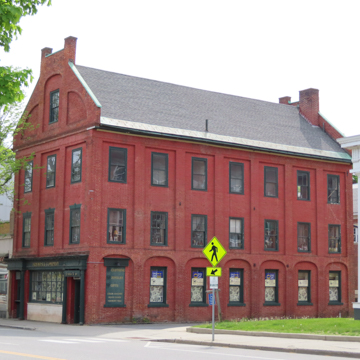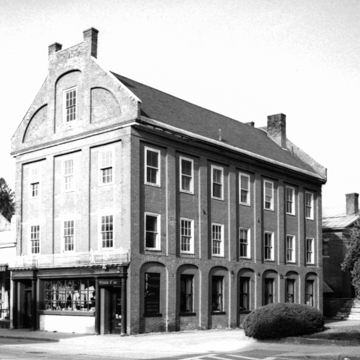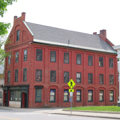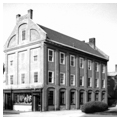The Pettes-Journal Block is the finest surviving brick, Federal commercial structure in the state and was probably one of the finest when it was built. A study in shallow recessed planes and sharply defined lines, the block shows off the skills of Windsor-area masons and their emulation of contemporary masonry in Boston. Above a base with elliptical-arched wall panels that frame first-floor windows, the front and north elevations rise through the second and third stories in single-bay, rectangular panels. The manipulation of surface continues into the Main Street parapet, where quarter-round panels flank a tall, elliptical-headed bay that contains a central window. This is a distinctive motif that was emulated on Return Brown's house in nearby West Windsor (WS37). Erected by Frederick Pettes, the building's hyphenated name refers to its occupancy by the Vermont Journal beginning in 1829 when editor Simeon Ide moved the paper here from the Old Constitution House. Other than a delicately detailed Colonial Revival Main Street storefront with column-supported entablature and iron balcony added in 1913, the building has been spared the change or destruction that claimed most of its commercial contemporaries. Ironically, it was from this beautiful building that the Vermont National Bank threatened neighboring Windsor House (WS39) with demolition in 1971.
You are here
Pettes-Journal Block
If SAH Archipedia has been useful to you, please consider supporting it.
SAH Archipedia tells the story of the United States through its buildings, landscapes, and cities. This freely available resource empowers the public with authoritative knowledge that deepens their understanding and appreciation of the built environment. But the Society of Architectural Historians, which created SAH Archipedia with University of Virginia Press, needs your support to maintain the high-caliber research, writing, photography, cartography, editing, design, and programming that make SAH Archipedia a trusted online resource available to all who value the history of place, heritage tourism, and learning.


















